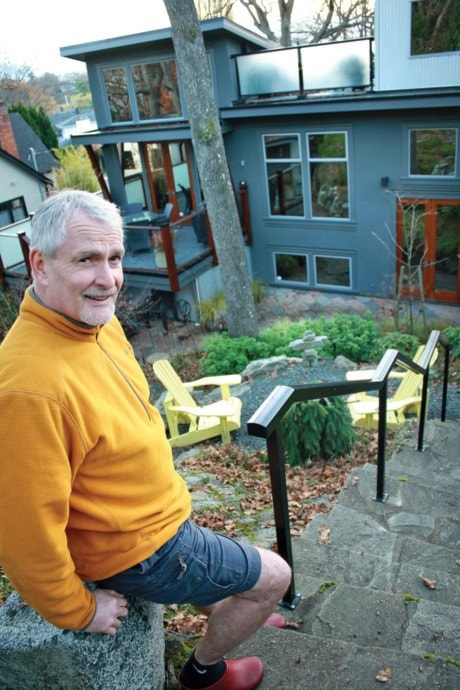Darrell Wells doesn’t have your typical cookie-cutter-style grassed yard.
His seven-year-old modern house stands at the bottom of a steep, rocky slope. And while the views are great from up top, so is the potential for rain to gush down the incline and into his basement.
“The houses on both sides of us have sump pumps,” Wells says. “The water just comes flying down.”
Luckily Wells’ builder foresaw the problem.
“He says, ‘Darrell, we got challenges,’” Wells recalls. “‘We got to really be careful about how we prevent this house from being flooded.’”
Forth Land Planning took over with a landscaping design.
At the base of the hill in the backyard, Wells has built up the soil using a retention wall, and has planted the low-lying area with various shrubs.
“We’ve never had a run-off issue,” he says.
Recently, Wells’ property caught the attention of Victoria’s public works staff. “I looked out the window and there was a camera set up out there (by the city),” he says.
Wells’ landscaping helps to manage rain water. It’s the type of thing the city is trying to encourage as it creates a new stormwater utility. The goal is to give people financial incentive for retaining more rain water on their own lot, rather than simply relying on storm drains to transport the water swiftly into the ocean.
Once the new utility launches, Victoria will be the first in the region to bill and rebate property owners according to the stress they place on the storm water system.
Criteria for rebates haven’t been determined yet, but people can take many steps to slow rain-water runoff. They include replacing paved driveways with imperious options such as interlocking blocks, as well as planting trees and building rain gardens.
The Capital Regional District promotes rain gardens, and provides education to help property owners build their own.
“The key message is we want to manage rain water on site, which removes contaminants and reduces the amount of water that enters the stormwater system,” says Brianne Czypyha, CRD environment science officer.
“The biggest difference between a rain garden and any other kind of garden is rather than the raised idea, it’s just simply a depressed garden area,” Czypyha says.
Water-loving plants are located at the bottom of the depression and the soil is mixed with compost for greater absorption of water.
As a very rough guide, a rain garden should be about 20 per cent as large as the roof, or driveway or other impervious surface whose run-off the garden will absorb.
But, warns Czypyha, it’s important to do your homework before you begin. Check with your municipality before disconnecting a downspout and investigate whether your plans will affect neighbours downhill from you.
For a step-by-step guide, visit crd.ca/raingardens and crd.ca/nativeplants for a list of water-loving and drought-tolerant plants.
If this sounds like a daunting amount of work, Cyzpyha says there are lots of simple steps property owners can take to slow runoff down – without building a rain garden.
“The thing I would recommend that anybody can do is build your soil,” she says.
To do that you can put a top dressing of compost or mulch on your lawn. “It’s the easiest thing and has the most impact.”
For Wells, rain retention is more a side benefit of his garden. He likes the balance of colours, shapes and textures. “It’s very diverse,” he says.
People often stop by to take a look, he adds, as he walks through his front yard, rattling off the names of the various low scrubby plants, tall grasses and trees.
Lining the sidewalk are waves of heather and clumps of blue fescue grass resembling porcupines. They discourage dogs from stopping to relieve themselves, Wells says with a laugh.
Check out Wells’ front yard at 1356 Richardson Ave.
rholmen@vicnews.com
